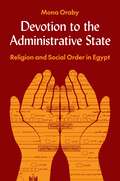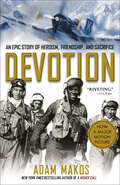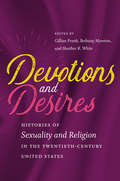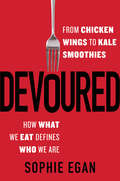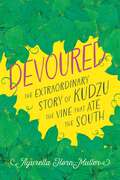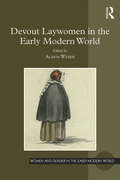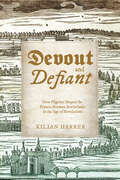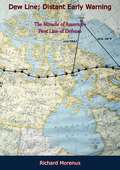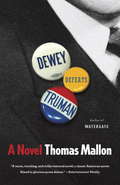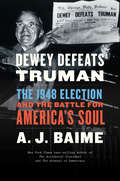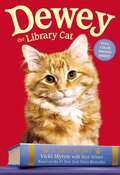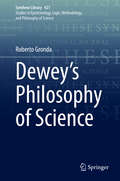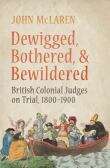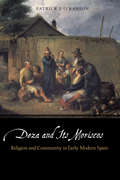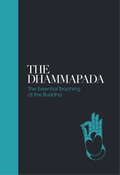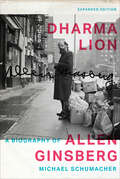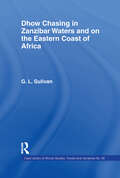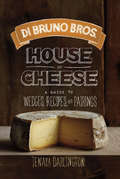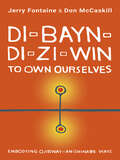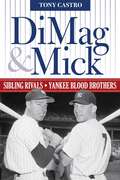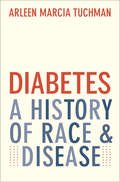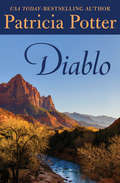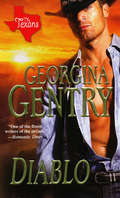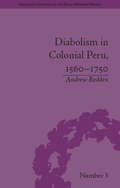- Table View
- List View
Devotion to the Administrative State: Religion and Social Order in Egypt
by Mona OrabyWhy the pursuit of state recognition by seemingly marginal religious groups in Egypt and elsewhere is a devotional practiceOver the past decade alone, religious communities around the world have demanded state recognition, exemption, accommodation, or protection. They make these appeals both in states with a declared religious identity and in states officially neutral toward religion. In this book, Mona Oraby argues that the pursuit of official recognition by religious minorities amounts to a devotional practice. Countering the prevailing views on secularism, Oraby contends that demands by seemingly marginal groups to have their religious differences recognized by the state in fact assure communal integrity and coherence over time. Making her case, she analyzes more than fifty years of administrative judicial trends, theological discourse, and minority claims-making practices, focusing on the activities of Coptic Orthodox Christians and Baháʼí in modern and contemporary Egypt.Oraby documents the ways that devotion is expressed across a range of sites and sources, including in lawyers&’ offices, administrative judicial verdicts, televised media and film, and invitation-only study sessions. She shows how Egypt&’s religious minorities navigated the political and legal upheavals of the 2011 uprising and now persevere amid authoritarian repression. In a Muslim-majority state, they assert their status as Islam&’s others, finding belonging by affirming their difference; and difference, Oraby argues, is the necessary foundation for collective life. Considering these activities in light of the global history of civil administration and adjudication, Oraby shows that the lengths to which these marginalized groups go to secure their status can help us to reimagine the relationship between law and religion.
Devotion: An Epic Story of Heroism, Friendship, and Sacrifice
by Adam MakosFor readers of Unbroken comes an unforgettable tale of courage from America's "forgotten war" in Korea, by the New York Times bestselling author of A Higher Call. <p><p>Devotion tells the inspirational story of the U.S. Navy's most famous aviator duo, Lieutenant Tom Hudner and Ensign Jesse Brown, and the Marines they fought to defend. A white New Englander from the country-club scene, Tom passed up Harvard to fly fighters for his country. An African American sharecropper's son from Mississippi, Jesse became the navy's first black carrier pilot, defending a nation that wouldn't even serve him in a bar. While much of America remained divided by segregation, Jesse and Tom joined forces as wingmen in Fighter Squadron 32. <p><p>Adam Makos takes us into the cockpit as these bold young aviators cut their teeth at the world's most dangerous job--landing on the deck of an aircraft carrier—a line of work that Jesse's young wife, Daisy, struggles to accept. Deployed to the Mediterranean, Tom and Jesse meet the Fleet Marines, boys like PFC "Red" Parkinson, a farm kid from the Catskills. In between war games in the sun, the young men revel on the Riviera, partying with millionaires and even befriending the Hollywood starlet Elizabeth Taylor. Then comes the war no one expected, in faraway Korea. <p><p>Devotion takes us soaring overhead with Tom and Jesse, and into the foxholes with Red and the Marines as they battle a North Korean invasion. As the fury of the fighting escalates and the Marines are cornered at the Chosin Reservoir, Tom and Jesse fly, guns blazing, to try and save them. When one of the duo is shot down behind enemy lines and pinned in his burning plane, the other faces an unthinkable choice: watch his friend die or attempt history's most audacious one-man rescue mission. <p><p>A tug-at-the-heartstrings tale of bravery and selflessness, Devotion asks: How far would you go to save a friend? <p> <b>New York Times Bestseller</b>
Devotions and Desires: Histories of Sexuality and Religion in the Twentieth-Century United States
by Bethany Moreton Gillian Frank Heather R. WhiteAt a moment when "freedom of religion" rhetoric fuels public debate, it is easy to assume that sex and religion have faced each other in pitched battle throughout modern U.S. history. Yet, by tracking the nation's changing religious and sexual landscapes over the twentieth century, this book challenges that zero-sum account of sexuality locked in a struggle with religion. It shows that religion played a central role in the history of sexuality in the United States, shaping sexual politics, communities, and identities. At the same time, sexuality has left lipstick traces on American religious history. From polyamory to pornography, from birth control to the AIDS epidemic, this book follows religious faiths and practices across a range of sacred spaces: rabbinical seminaries, African American missions, Catholic schools, pagan communes, the YWCA, and much more. What emerges is the shared story of religion and sexuality and how both became wedded to American culture and politics. The volume, framed by a provocative introduction by Gillian Frank, Bethany Moreton, and Heather R. White and a compelling afterword by John D'Emilio, features essays by Rebecca T. Alpert and Jacob J. Staub, Rebecca L. Davis, Lynne Gerber, Andrea R. Jain, Kathi Kern, Rachel Kranson, James P. McCartin, Samira K. Mehta, Daniel Rivers, Whitney Strub, Aiko Takeuchi-Demirci, Judith Weisenfeld, and Neil J. Young.
Devoured: From Chicken Wings to Kale Smoothies—How What We Eat Defines Who We Are
by Sophie EganA provocative look at how and what Americans eat and why—a flavorful blend of The Omnivore’s Dilemma, Salt Sugar Fat, and Freakonomics that reveals how the way we live shapes the way we eat.Food writer and Culinary Institute of America program director Sophie Egan takes readers on an eye-opening journey through the American food psyche, examining the connections between the values that define our national character—work, freedom, and progress—and our eating habits, the good and the bad. Egan explores why these values make for such an unstable, and often unhealthy, food culture and, paradoxically, why they also make America’s cuisine so great.Egan raises a host of intriguing questions: Why does McDonald’s have 107 items on its menu? Why are breakfast sandwiches, protein bars, and gluten-free anything so popular? Will bland, soulless meal replacements like Soylent revolutionize our definition of a meal? The search for answers takes her across the culinary landscape, from the prioritization of convenience over health to the unintended consequences of “perks” like free meals for employees; from the American obsession with “having it our way” to the surge of Starbucks, Chipotle, and other chains individualizing the eating experience; from high culture—artisan and organic and what exactly “natural” means—to low culture—the sale of 100 million Taco Bell Doritos Locos Tacos in ten weeks. She also looks at how America’s cuisine—like the nation itself—has been shaped by diverse influences from across the globe.Devoured weaves together insights from the fields of psychology, anthropology, food science, and behavioral economics as well as myriad examples from daily life to create a powerful and unique look at food in America.
Devoured: The Extraordinary Story of Kudzu, the Vine That Ate the South
by Ayurella Horn-MullerKudzu abounds across the American South. Introduced in the United States in the 1800s as a solution for soil erosion, this invasive vine with Eastern Asian origins came to be known as a pernicious invader capable of smothering everything in its path. To many, the plant’s enduring legacy has been its villainous role as the “vine that ate the South.” But for a select few, it has begun to signify something else entirely. In its roots, a network of people scattered across the country see a chance at redemption—and an opportunity to rewrite a fragment of troubled history.Devoured: The Extraordinary Story of Kudzu, the Vine That Ate the South detangles the complicated story of the South’s fickle relationship with kudzu, chronicling the ways the boundless weed has evolved over centuries, and dissecting what climate change could mean for its future across the United States. From architecture teams experimenting with it as a sustainable building material, to clinical applications treating binge-drinking, to chefs harvesting it as a wild edible, environmental journalist Ayurella Horn-Muller spotlights how kudzu’s notorious reputation in America is gradually being cast aside in favor of its promise.Weaving careful research with personal stories, Horn-Muller investigates how kudzu morphed from a miraculous agricultural solution to the monstrous archetypal foe of the southern landscape. Devoured is a poignant narrative of belonging, racial ambiguity, outsiders and insiders, and the path from universal acceptance to undesirability. It is a deeply reported exploration of the landscapes that host the many species we fight to control. Above all, Devoured is an ode to the earth around us—a quest for meaning in today’s imperiled world.
Devout Laywomen in the Early Modern World (Women and Gender in the Early Modern World)
by Alison WeberDevout laywomen raise a number of provocative questions about gender and religion in the early modern world. How did some groups or individuals evade the Tridentine legislation that required third order women to take solemn vows and observe active and passive enclosure? How did their attempts to exercise a female apostolate (albeit with varying degrees of success and assertiveness) destabilize hierarchies of class and gender? To the extent that their beliefs and practices diverged from approved doctrine and rituals, what insights can they provide into the tensions between official religion and lay religiosity? Addressing these and many other questions, Devout Laywomen in the Early Modern World reflects new directions in gender history, offering a more nuanced approach to the paradigm of woman as the prototypical "disciplined" subject of church-state power.
Devout and Defiant: How Pilgrims Shaped the Franco-German Borderlands in the Age of Revolutions (Studies in Early Modern German History)
by Kilian HarrerHow Catholic pilgrims in an era of revolution challenged state authority and redefined the practice of their faith In the days of the French Revolution, as zealous government officials sought to sweep away the vestiges of a less enlightened age, they made a concerted effort to clamp down on religious &“superstition&” and to fix modern territorial boundaries. Catholic pilgrims on the western edge of German-speaking Europe, however, refused to let worldly barriers stand in the way of their devotional practices. As Kilian Harrer reveals in this groundbreaking book, pilgrimage became a form of transgressive devotion that spurred religious renewal. By the hundreds of thousands, pilgrims exposed the limits of state authority as they traveled to shrines and holy sites across the borderlands that stretched from Luxembourg in the north to Alsace and Switzerland in the south. These Catholics evaded passport controls, crossed provocatively into Protestant territories, and went abroad to visit shrines beyond the reach of anticlerical officials. Pilgrims and pilgrimage organizers reshaped the politics of religion by grappling with shifting borders, dramatic regime change, and police repression. In the end, they reoriented Catholicism itself as they boldly confronted the state-led policing of borders and worship.
Dew Line; Distant Early Warning: The Miracle of America's First Line of Defense
by Richard MorenusDEW LINE—the story of America’s best kept secret now can be told. This is the story of the three-thousand-mile Distant Early Warning line—America’s electronic Paul Revere. Spanning the northernmost reaches of the North American Continent, it stands as an impregnable radar fence against large-scale attack across North Polar regions by enemy long-range bombers and fighter planes.DEW LINE is the dramatic account of how the almost impossible task of building this final link in the 10,000-mile warning loop around our country was accomplished. From the initial period of planning in the summer of 1952, from the building of an experimental span across the Arctic shore of Alaska, to the ultimate completion of the 3,000 miles of radar installation with the back-breaking task of flying in personnel and equipment to build these stations in sub-zero temperatures in the long Arctic nights—all is recounted as the vivid story of accomplishment it is.
Dewey Defeats Truman
by Thomas MallonFrom a writer whose last book, Henry and Clara, prompted John Updike to declare Thomas Mallon one of the most interesting American novelists at work, comes a story that perfectly captures the delightful romance and wistful magic of our recent, and more innocent, past.Thomas Mallon has masterfully appropriated a jubilant legend (and famous headline) of modern American history -- Harry Truman's upset victory over Thomas E. Dewey in the 1948 presidential election -- and built around it a midwestern Midsummer Night's Dream. Set in Dewey's hometown of Owosso, Michigan, this is the captivating story of a local love triangle that mirrors the national election contest. As the voters must decide between candidates, so must Anne Macmurray choose between two suitors: an ardent UAW organizer and his polar opposite, a wealthy lawyer who's certain he will ride to state Senate victory on Republican coattails.As they weave a small-town tapestry of dreams and secrets, the people of Owosso ready themselves for the fame that is bound to shower down upon them after Dewey's "sure thing" victory. But as the novel -- and history -- move toward election night, we watch the citizens of Owosso, Anne Macmurray and her suitors in particular, await the outcome of the election and the rearrangement of their fates in a climax filled with suspense, chagrin, and unexpected joy.
Dewey Defeats Truman: The 1948 Election and the Battle for America's Soul
by A. J. BaimeFrom the New York Times best-selling author of The Accidental President comes the thrilling story of the 1948 presidential election, one of the greatest election stories of all time, as Truman mounted a history-making comeback and staked a claim for a new course for America. On the eve of the 1948 election, America was a fractured country. Racism was rampant, foreign relations were fraught, and political parties were more divided than ever. Americans were certain that President Harry S. Truman’s political career was over. “The ballots haven’t been counted,” noted political columnist Fred Othman, “but there seems to be no further need for holding up an affectional farewell to Harry Truman.” Truman’s own staff did not believe he could win. Nor did his wife, Bess. The only man in the world confident that Truman would win was Mr. Truman himself. And win he did. 1948 was a fight for the soul of a nation. In Dewey Defeats Truman, A. J. Baime sheds light on one of the most action-packed six months in American history, as Truman not only triumphs, but oversees watershed events—the passing of the Marshall plan, the acknowledgement of Israel as a new state, the careful attention to the origins of the Cold War, and the first desegregation of the military. Not only did Truman win the election, he succeeded in guiding his country forward at a critical time with high stakes and haunting parallels to the modern day.
Dewey The Library Cat: A True Story
by Vicki Myron Bret Witter<P>Now everyone's favorite library cat can inspire a new audience of young readers with his story of courage and love. <P>Abandoned in a library book drop slot in the dead of winter, this remarkable kitten miraculously endured the coldest night of the year. <P>Dewey Readmore Books, as he became known, quickly embraced his home inside Spencer's public library, charming the struggling small town's library-goers, young and old. <P>As word of Dewey's winning tail, or rather his tale, spread, the library cat gained worldwide fame as a symbol of hope and proof positive that one small cat could change a town, one reader at a time.
Dewey's Philosophy of Science (Synthese Library #421)
by Roberto GrondaThis monograph presents a unitary account of Dewey’s philosophy of science and demonstrates the relevance for contemporary debates. The book is written from a theoretical angle and explains Dewey's via on Experience, Language, Inquiry, Construction and Realism. Via taking this route the book addresses key philosophical problems - such as the nature of language, the idea of experience, the notion of logical constructivism, the criticism of representationalism and the nature of scientific practices.John Dewey (1859-1952) is one of the most representative philosophers of the United States. He is well known for his work in education, psychology and social reform and one of the primary figures associated with the philosophy of pragmatism. His Philosophy of Science underwent a period of almost total unpopularity and neglect. In recent times, however, as a consequence of the strong pragmatist renaissance we are now witnessing, Dewey’s philosophy of science has attracted new attention. This book presents for the first time a comprehensive overview of Dewey's philosophy of science and will be of interest to scholars working in nineteenth and twentieth century philosophy of science and on the relationship between Pragmatism and Logical Empiricism.
Dewigged, Bothered, and Bewildered
by John MclarenThroughout the British colonies in the nineteenth century, judges were expected not only to administer law and justice, but also to play a significant role within the governance of their jurisdictions. British authorities were consequently concerned about judges' loyalty to the Crown, and on occasion removed or suspended those who were found politically subversive or personally difficult. Even reasonable and well balanced judges were sometimes threatened with removal.Using the career histories of judges who challenged the system, Dewigged, Bothered, and Bewildered illuminates issues of judicial tenure, accountability, and independence throughout the British Empire. John McLaren closely examines cases of judges across a wide geographic spectrum -- from Australia to the Caribbean, and from Canada to Sierra Leone -- who faced disciplinary action. These riveting stories provide helpful insights into the tenuous position of the colonial judiciary and the precarious state of politics in a variety of British colonies.
Deza and Its Moriscos: Religion and Community in Early Modern Spain (Early Modern Cultural Studies)
by Patrick J. O'BanionDeza and Its Moriscos addresses an incongruity in early modern Spanish historiography: a growing awareness of the importance played by Moriscos in Spanish society and culture alongside a dearth of knowledge about individuals or local communities. By reassessing key elements in the religious and social history of early modern Spain through the experience of the small Castilian town of Deza, Patrick J. O&’Banion asserts the importance of local history in understanding large-scale historical events and challenges scholars to rethink how marginalized people of the past exerted their agency. Moriscos, baptized Muslims and their descendants, were pressured to convert to Christianity at the end of the Middle Ages but their mass baptisms led to fears about lingering crypto-Islamic activities. Many political and religious authorities, and many of the Moriscos&’ neighbors as well, concluded that the conversions had produced false Christians. Between 1609 and 1614 nearly all of Spain&’s Moriscos—some three hundred thousand individuals—were thus expelled from their homeland. Contrary to the assumptions of many modern scholars, rich source materials show the town&’s Morisco minority wielded remarkable social, economic, and political power. Drawing deeply on a diverse collection of archival material as well as early printed works, this study illuminates internal conflicts, external pressures brought to bear by the Inquisition, the episcopacy, and the crown, and the possibilities and limitations of negotiated communal life at the dawn of modernity.
Dhammapada: The Essential Teachings of the Buddha
by Max MullerIn more than 400 verses the Buddha clearly expounds his noble path of virtue for everyman. This foundation scripture teaches the supreme doctrine of nirvana and the way to the highest possible happiness for mankind. Oxford professor Dr. Max Muller, a great scholar and Orientalist, did the translation.
Dharma Lion: A Biography of Allen Ginsberg
by Michael SchumacherWith the sweep of an epic novel, Michael Schumacher tells the story of Allen Ginsberg and his times, with fascinating portraits of Jack Kerouac, Neal Cassady, and William Burroughs, among others, along with many rarely seen photographs.
Dharmayoddha Kalki Vishnu Ka Avatar: धर्मयोद्धा कल्कि विष्णु का अवतार
by Kevin Missalधर्मयोद्धा कल्कि: विष्णु का अवतार केविन मिसल की एक काल्पनिक कथा है, जो भारतीय पुराणों के कल्कि अवतार से प्रेरित है। यह कहानी एक साधारण व्यक्ति कल्कि की है, जिसे भगवान विष्णु का अंतिम अवतार माना जाता है, और जो दुष्ट शक्तियों के प्रतीक काली के खिलाफ लड़ता है। तीन भागों में विभाजित, उपन्यास में कल्कि की यात्रा को दिखाया गया है—पहले भाग में कल्कि का मानसिक और शारीरिक विकास होता है, दूसरे में काली का उदय और उसकी अराजकता, और अंतिम भाग में कल्कि और काली के बीच निर्णायक युद्ध होता है। यह कहानी अच्छाई और बुराई के बीच संघर्ष और कल्कि के साहस, नेतृत्व और बलिदान की है।
Dhow Chasing in Zanzibar Waters: And on the Eastern Coast of Africa. Narrative of Five Years' Experience in
by Captain G.L. SullivanA useful guide to the state of the slave trade in 1850 and how the trade increased from then until 1873 when up to three times the amount of slaves were being traded. First published in 1873.
Di Bruno Bros. House of Cheese: A Guide to Wedges, Recipes, and Pairings
by Tenaya DarlingtonPeek behind Philadelphia’s largest and oldest cheese counter for a lively guide to pairing cheese with everything from beer and cocktails to olives and charcuterie. The store’s resident cheese blogger, Madame Fromage, brings to life 170 of the world’s greatest artisan cheeses, drawing on stories and knowledge from the store’s third-generation owners. The book offers 30 recipes, from Cheddar Ale Soup to Rogue River Sushi, along with a dairy lexicon, notes on how to taste cheese, and a variety of themed boards: a Fireside Party, an All-Goat Blow-Out, and a selection of Desk Bento. Beautiful four-color photographs serve to put names with wheels and wedges of cheese.
Di-bayn-di-zi-win (To Own Ourselves): Embodying Ojibway-Anishinabe Ways
by Jerry Fontaine Don McCaskillA collaboration exploring the importance of the Ojibway-Anishinabe worldview, use of ceremony, and language in living a good life, attaining true reconciliation, and resisting the notions of indigenization and colonialization inherent in Western institutions.Indigenization within the academy and the idea of truth and reconciliation within Canada have been seen as the remedy to correct the relationship between Indigenous Peoples and Canadian society. While honourable, these actions are difficult to achieve given the Western nature of institutions in Canada and the collective memory of its citizens, and the burden of proof has always been the responsibility of Anishinabeg.Authors Makwa Ogimaa (Jerry Fontaine) and Ka-pi-ta-aht (Don McCaskill) tell their di-bah-ji-mo-wi-nan (Stories of personal experience) to provide insight into the cultural, political, social, and academic events of the past fifty years of Ojibway-Anishinabe resistance in Canada. They suggest that Ojibway-Anishinabe i-zhi-chi-gay-win zhigo kayn-dah-so-win (Ways of doing and knowing) can provide an alternative way of living and thriving in the world. This distinctive worldview — as well as Ojibway-Anishinabe values, language, and ceremonial practices — can provide an alternative to Western political and academic institutions and peel away the layers of colonialism, violence, and injustice, speaking truth and leading to true reconciliation.
DiMag & Mick: Sibling Rivals, Yankee Blood Brothers
by Tony CastroDiMag & Mick is a portrait of DiMaggio and Mantle as the old and young exemplars of what was a more confident, masterful age not only in baseball but in the country where they were held up as cultural heroes over two generations, symbolic of an America celebrating its recent triumph over Nazism and ever-curious about the new age of color television, rocket ships, and technology. Tony Castro shows DiMag and Mick as fathers and sons, rebels and heroes, and reveals the rite of passage of two men who would go down in baseball immortality – DiMaggio as he reluctantly prepares to leave the spotlight of adoration and hero-worship for glitzy world of Marilyn&’s exploding Hollywood celebrity, and Mantle in his awkward attempt to leave his country roots of Dust Bowl Oklahoma for the big city exposure and expectations of greatness being placed on him. Yankee legend and glory holds a special magic all its own, and Castro examines the heart and soul of that mystique, especially the bond of the players themselves and how that came to breed and spread the perception that there was any animosity between DiMaggio and Mantle – two polarizing personalities who drove many teammates away from one and galvanized their friendship with the other.
Diabetes: A History of Race and Disease
by Arleen Marcia TuchmanWho gets diabetes and why? An in‑depth examination of diabetes in the context of race, public health, class, and heredity Who is considered most at risk for diabetes, and why? In this thorough, engaging book, historian Arleen Tuchman examines and critiques how these questions have been answered by both the public and medical communities for over a century in the United States. Beginning in the late nineteenth century, Tuchman describes how at different times Jews, middle‑class whites, American Indians, African Americans, and Hispanic Americans have been labeled most at risk for developing diabetes, and that such claims have reflected and perpetuated troubling assumptions about race, ethnicity, and class. She describes how diabetes underwent a mid-century transformation in the public&’s eye from being a disease of wealth and &“civilization&” to one of poverty and &“primitive&” populations. In tracing this cultural history, Tuchman argues that shifting understandings of diabetes reveal just as much about scientific and medical beliefs as they do about the cultural, racial, and economic milieus of their time.
Diablo: Diablo, Defiant, And Wanted (Romance Ser.)
by Patricia PotterThe most wanted desperado in Texas and the young woman he must betray to save his own life are unlikely lovers in this passionate, fast-paced historical romance by award-winning author Patricia Potter His enemies call him Diablo, but once he was a captain in the Confederate army. Kane O&’Brien is now a condemned convict facing death. His only hope of survival is to become a spy for the Yankees, who need him to infiltrate and destroy a notorious outlaw hideout. But in the Sanctuary, he meets a spirited beauty who makes him think twice about his mission. Nicky Thompson wants only to escape the Sanctuary, the place that was once a haven for her and her brother, and never look back—until the deadly outlaw Diablo seeks refuge there. The sensual, scarred stranger awakens powerful yearnings in her that threaten her independent spirit. As desire ignites into a dangerous passion, Nicky begins a perilous journey during which she must entrust her life to an irresistible man whose terrible secret may doom them both.
Diablo: The Texans (The Texans #1)
by Georgina GentryMeet the Texans--rough-hewn heroes as bold and rugged as the Lone Star State itself--in a sweeping new series only Georgina Gentry could bring to heart-pounding, hard-riding life. . .DiabloThey call him "Devil," and with good reason. The half-breed Santee Sioux bears the twisted scars that made him the fastest, deadliest gunfighter in Texas. Diablo will never forget the kind cattleman who once took him in, but it is his torturer who haunts his every thought. And when some powerful Wyoming ranchers come looking to hire ruthless men for a wicked job, Diablo seizes the opportunity to settle a score. . .Her name is Sunny, and she more than lives up to it. She's a dazzling ray of light--and the bride-to-be of Hurd Kruger, the man who scarred Diablo. What better way to destroy Kruger than to capture, dishonor, and dump his greatest prize? It's a perfect plan, except for the one thing Diablo never counted on. . .the only thing that could turn him away from the dark side, the angel who could save his bedeviled soul. . ."Gentry brings the West and her characters to life and give her fans hours of tru reading pleasure."---Romantic Times
Diabolism in Colonial Peru, 1560–1750 (Religious Cultures in the Early Modern World #3)
by Andrew ReddenUses a multidisciplinary approach to investigate the transcultural phenomenon of the devil in early modern Peru. This work demonstrates that the interaction between the Christian and the Andean worlds was far more complex than any interpretation that posits a clear dichotomy between conversion and resistance would suggest.
